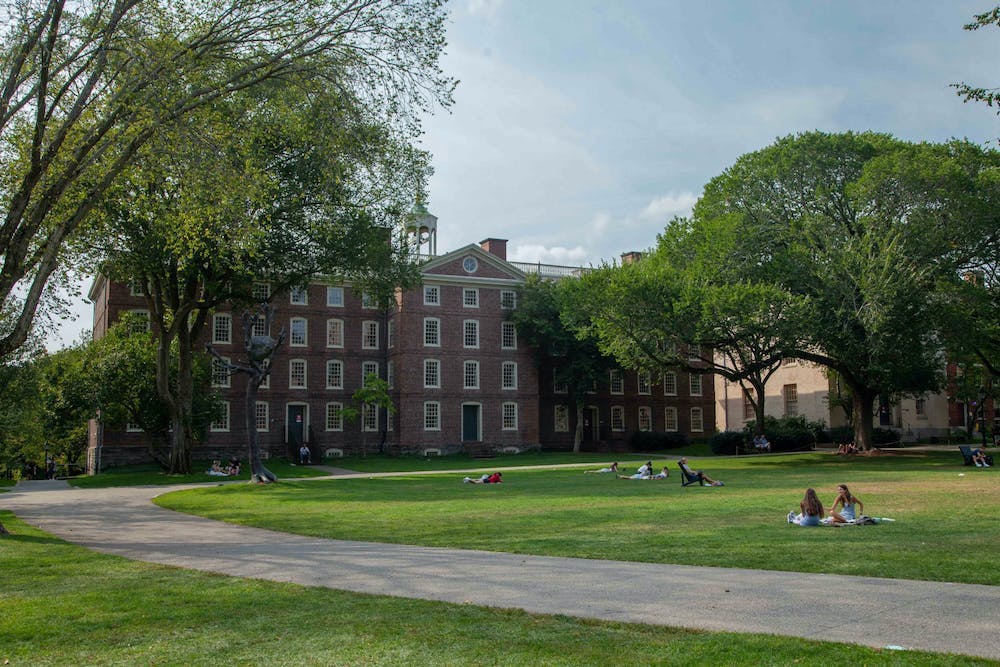Framed by the Van Wickle Gates, University Hall is a symbol of the University’s centuries-long history and prestige. To this day, the building’s 300-pound bell, hung in 1792, echoes loudly across the Main Green to signal the end of each class period.
According to the Brown University Campus Map, University Hall — built in 1770 — is one of seven existing college buildings in the United States that predates the American Revolution, making it the University’s oldest building.
Zoe Siegel ’25, who has attended several advising meetings in University Hall, said that she never took particular notice of the building’s history, despite being aware of its age. “There are a lot of historical decorations” inside, she said. “But I’ve never looked that closely at them.”
The first time University Hall was mentioned in Brown’s historical archives, then as an unnamed college building, was in the diary of Hezekiah Smith, an “early supporter” of the University. According to Encyclopedia Brunoniana, Smith wrote that the Corporation, the University’s highest governing body, “subscribed nineteen hundred and ninety-two dollars for the building, and for endowing the College.”
The proposed building, which would initially be known as the College Edifice, underwent multiple stages of planning under different committees before being finalized.
The University, then called Rhode Island College, was based in Warren, Rhode Island before the College Edifice was erected. The creation of the building in Providence marked both a new location for the College and a new era that would stretch into the present day.
Reflecting on University Hall’s connection to slavery
In 1770, Nicholas Brown and Company began construction on the College Edifice. According to Encyclopedia Brunoniana, the building committee placed a notice in the Providence Gazette asking for donations of building materials. The company was involved in the Atlantic slave trade, according to the Report of the Brown University Steering Committee on Slavery and Justice.
Donors financed the construction of the College Edifice in forms other than pure monetary donations, according to the Slavery and Justice report. The wood for the building was donated by Lopez and Rivera, “one of the largest slave trading firms in Newport.”
Other donors honored their pledges by providing slave labor. There is evidence of four enslaved men who worked on the building, including “Pero,” “Mary Young’s Negro Man,” “Earle’s Negro” and “Abraham,” according to the report.
Allison Masthay ’25, who lives in Hope College — the second oldest building on campus, located next to University Hall — said that she has not paid much attention to the University’s first building during her time at Brown. “I just see it as another one of the pretty buildings on the Main Green,” she said.
Masthay was not aware of the building’s relationship with the slave trade. “I think this is yet another example of the importance of awareness and education,” she said. “Everyone should know the building’s origins, … (it) shouldn’t be swept under the rug.”
Kanayo Duru ’25 also said he was not aware of the history of University Hall, but he did know about the larger role that the slave trade played in financing the University.
“It just goes to show how deeply ingrained the slave trade is in Brown’s history,” he said. “It’s ingrained in the very foundations of our buildings.”
The many forms of University Hall
In December 1776, the R.I. legislature took control of the Edifice to use as barracks and a hospital for American troops. The College retook possession of the Edifice in May 1780 for a short period before the building was given to the French army to be used as a hospital, during which it bore a significant amount of damage. In 1800, the Corporation collected a “very inadequate” settlement of $2,779.13 for the destruction.
In 1822, the Edifice was renamed “University Hall.” Over two decades later, the building underwent renovations that enlarged the rooms, created offices for the president, registrar and steward, increased the number of student rooms from 38 to 44 and introduced gas light, steam heat and plumbing in the basement.
For much of its history, part of the building served as one of the many dormitories that students could live in. But in 1939, the Hall was almost entirely converted into an administrative building. The renovation and restoration that year revealed that “only portions of the cupola and two large beams on the fourth floor were the original woodwork of the 1770s,” according to the University map.
A 1963 Herald article reported that University Hall would be dedicated as a national historic landmark later that year. A representative of the Department of Interior called the building an “exceptionally valuable survival of the nation’s past,” according to an article published the day after the dedication ceremony.
At the ceremony, William H. Jordy, a former art professor, spoke about University Hall's history. At the time of its creation, he said, the Boston Gazette called it a “College near as large as Babel; sufficient to contain ten times the number of students that ever have, or ever will, oblige the tutors of that popular University with the opportunity of educating or instructing them.”





